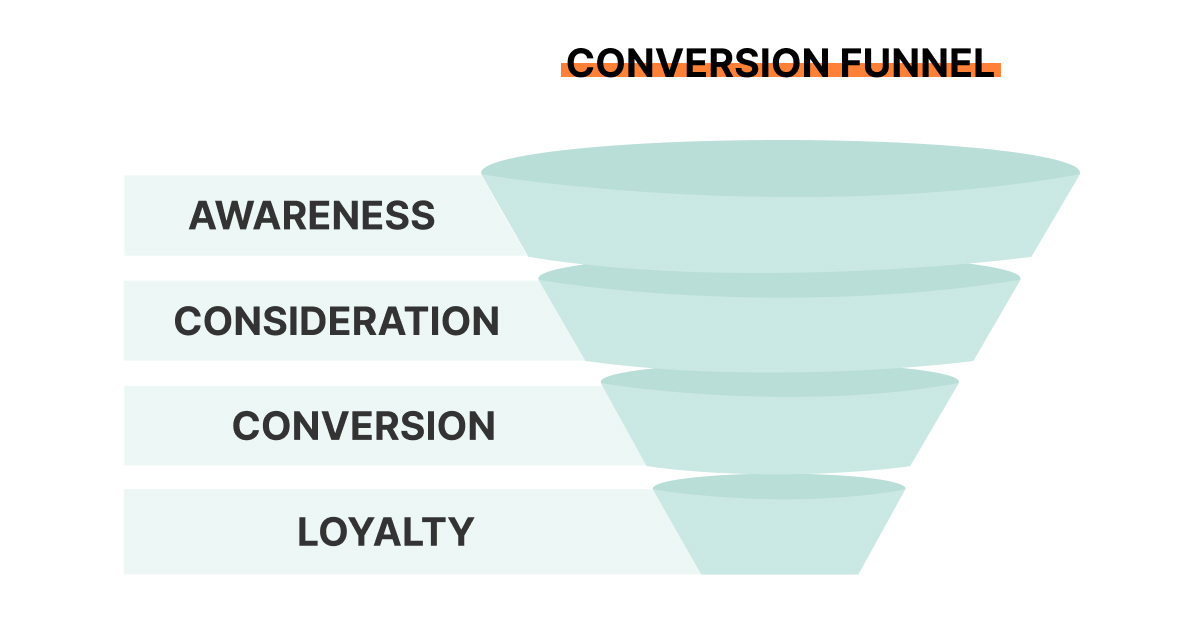
In the world of Digital Marketing, where the competition is fierce and the opportunities are fleeting, the efficiency of your strategies is crucial in turning website visitors into satisfied customers.
A fundamental tool in this process is the "conversion funnel", a concept that has become the cornerstone of successful online campaigns and one of the most well-known Inbound Marketing tactics. You may have heard similar terms for this process, such as the Marketing Funnel, Buyer's Journey, or Customer Journey. Let's take a deeper look.
What is the conversion funnel?
The conversion funnel is a visual representation of the journey a user takes from their first contact with your brand until they take a desired action, such as subscribing, downloading, or making a purchase.
Similar to a real-life funnel, this process starts with a wide range of potential visitors at the top and narrows down as they progress through different stages, ultimately leaving only those who have completed the conversion at the bottom.

Stages of the conversion funnel:
-
Awareness: In the first stage of the funnel, the user discovers your brand, product or service. They may arrive through different channels, such as organic search engines, paid advertising, social media, recommendations from friends, or referrals from other websites. Here, the main objective is to grab the user’s attention and pique their interest so that they feel motivated to continue moving through the funnel.
-
Consideration: In the consideration stage, users have shown a significant interest in what you offer and are evaluating whether your product or service meets their needs and expectations. This is where you should highlight the unique benefits you provide, compare yourself to the competition, and provide references and reviews from satisfied customers. The goal is to build trust and persuade the user to move on to the next phase.
-
Conversion: The conversion phase is the ultimate goal of the funnel. At this point, the user takes the desired action, whether it's making a purchase, subscribing, downloading, or any other goal you've set. It's essential to ensure that the conversion experience is smooth and satisfying for the user. This includes a clear and secure payment process, purchase confirmations, and immediate gratification if possible.
-
Loyalty: Once the conversion is achieved, it's not the end of the funnel; in fact, it's the beginning of an ongoing relationship with the customer. The loyalty stage focuses on maintaining customer loyalty and turning them into advocates for your brand. Offering excellent customer service, providing relevant and personalized content, and building trust in your brand are key aspects to encourage retention and positive word-of-mouth.
The importance of optimizing the conversion funnel
The conversion funnel is a very valuable tool, but its true potential lies in its capacity for continuous improvement. Funnel optimization is a process where you analyze data and user behavior at each stage to identify potential weak points or areas of opportunity. Some strategies to optimize the funnel include:
-
Tracking and Data Analysis: Use analytical tools to track user behavior at each stage of the funnel. Identify which stages have the highest abandonment rates and which areas can be improved. With this data, you can make informed decisions to adjust your strategy.
-
Content Personalization: Offering personalized content based on user preferences and needs can significantly increase the likelihood that they will continue progressing through the funnel. Use segmentation to send more relevant and tailored messages to each user.
-
A/B Testing: Conduct A/B tests on different elements of your website and funnel, such as headlines, calls to action (CTAs), colors, and designs. This will allow you to identify which variations yield better results and apply those lessons to improve conversion.
-
Sales Process Optimization: Ensure that the purchase process is simple and efficient. Reduce friction and avoid asking for unnecessary information that may deter users.
-
Effective Communication: Maintain constant communication with your users throughout their journey in the funnel. Provide useful information, answer their questions, and build trust in your brand.
By focusing on the user, providing a unique and valuable experience, and constantly learning from your data, you’ll be on the path to turning your visitors into loyal and satisfied customers. Don’t underestimate the power of the conversion funnel; it is the key to success in the competitive world of digital marketing. Dare to harness its full potential and achieve the success you deserve!
As a HubSpot partner agency, at mbudo, we assist you with the strategy to guide your audience throughout the entire buyer journey, taking your brand to the next level. Shall we talk?

Alejandro Reviriego de la Torre
Alejandro has a marketing degree. He is a neuromarketing enthusiast who always aspires to get the best out of each project, a perfectionist, curious and a fighter who is dedicated to constantly improve himself.
It may interest you
LATEST
BLOG POSTS
SUBSCRIBE TO MBUDO BLOG
And get your inbound news directly in
your inbox, once a month.


